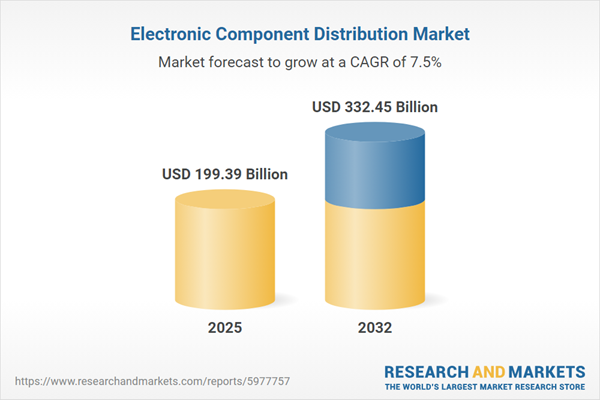Speak directly to the analyst to clarify any post sales queries you may have.
Senior decision-makers in the electronic component distribution market are contending with rapid digital transformation, heightened supply chain complexity, and swift changes in procurement. Strategic agility and real-time data adoption are increasingly essential as organizations work to future-proof their operations and sustain competitive advantage.
Market Snapshot: Electronic Component Distribution Market Overview
The electronic component distribution market is witnessing robust expansion, underscored by momentum in automotive and aerospace innovation, surging demand for consumer electronics, and the ongoing shift toward industrial automation. Supply chains are becoming more digital and integrated, driving efficiency and optimizing sourcing workflows. As product cycles shorten and specialized procurement platforms mature, leaders are prioritizing adaptability. Consolidation across the industry drives new operational models and prompts distributors to recalibrate strategies as customer requirements rapidly change.
Scope & Segmentation: Strategic Dimensions in Electronic Component Distribution
This report delivers comprehensive, actionable insights for executive leadership by dissecting the market along critical segments. Each area informs strategic investment and operational decisions for stakeholders navigating the dynamic landscape of electronic distribution.
- Component Types: In-depth analysis of active components (diodes, integrated circuits, microcontrollers, optocouplers, transistors) and passive components (capacitors, filters, inductors, resistors, transformers), all foundational to electronics manufacturing and design.
- Diode Sub-Types: Evaluation of LEDs, photodiodes, rectifiers, Schottky diodes, and Zener diodes, essential in automation environments and communication systems where reliability significantly impacts performance.
- Capacitor Variations: Comparison of ceramic, electrolytic, film, mica, tantalum, and supercapacitors with industrial and high-demand consumer applications in focus, highlighting performance and durability considerations.
- Application Verticals: Coverage spanning aerospace, defense, automotive (encompassing electric and autonomous vehicles), renewable energy, consumer electronics, medical technology, industrial automation, computing, communications, and lighting, with a focus on sector-specific supply chain and regulatory dynamics.
- Distribution Channels: Examination of direct distribution, retail, e-commerce, and omnichannel strategies to understand how businesses respond to evolving buyer behaviors and partnership needs.
- Regional Coverage: Analytical lens on the Americas, Europe, Asia-Pacific, Middle East, and Africa, including actionable insights for the United States, China, India, Germany, Japan, Canada, Mexico, Brazil, Argentina, and the UK, providing clarity on diverse market forces and regulatory frameworks.
- Company Profiles: Profiles of leading industry participants such as Arrow Electronics, Avnet, Fusion Worldwide, Digi-Key, Mouser Electronics, Future Electronics, WPG Holdings, Rutronik, and Brevan Electronics, regarding partnership strategies, innovation roadmaps, and scalable growth models.
Key Takeaways for Senior Decision-Makers
- Embracing digital transformation, including predictive analytics and transactional automation, reshapes procurement processes and strengthens supplier engagement across the value chain.
- Industry consolidation is driving transformation in operational approaches, encouraging the adoption of broader value-added offerings for sustained competitive positioning.
- Advanced technical support and tailor-made kitting services play a rising role in ensuring compliance and expediting product rollouts—particularly critical for sectors with stringent standards.
- Diversification of supply chains through nearshoring and regional partnerships enhances market resilience and mitigates exposure to trade or regulatory uncertainty.
- Collaboration intensifies between distributors and manufacturers, especially within electric vehicle and renewable energy domains, as industry participants seek to leverage sector-specific expertise for more robust market entry and growth.
- Implementing real-time inventory management tools and application programming interface-based procurement systems enhances partner connectivity and network visibility, fostering increased flexibility in response to demand shifts.
Tariff Impact: US Trade Measures and Distribution Strategy
Recent adjustments to US tariff policies have led organizations to diversify sourcing by expanding supplier networks into regions such as Southeast Asia and Latin America. This approach strengthens market resilience and underscores the importance of responsive supply frameworks within an evolving global trade environment.
Methodology & Data Sources
Findings derive from executive interviews, comprehensive surveys spanning manufacturing and distribution, in-depth financial analysis, and targeted market assessments. This mixed-methods approach ensures that recommendations align with the decision-making priorities of senior leaders operating in electronic component distribution.
Why This Report Matters in Electronic Component Distribution
- Offers strategic analysis across geographic, technical, and operational dimensions tailored for senior management and business planners.
- Serves as a benchmark tool for executing digital transformation and navigating ongoing industry shifts with confidence.
- Delivers actionable strategies for optimizing sourcing, ensuring regulatory compliance, and strengthening supply chain frameworks for resilient, long-term growth.
Conclusion
This report equips senior leaders with data-driven guidance to refine distribution strategies, enhance operational agility, and proactively identify new growth opportunities within the evolving electronic component distribution market.
Additional Product Information:
- Purchase of this report includes 1 year online access with quarterly updates.
- This report can be updated on request. Please contact our Customer Experience team using the Ask a Question widget on our website.
Table of Contents
3. Executive Summary
4. Market Overview
7. Cumulative Impact of Artificial Intelligence 2025
Companies Mentioned
The companies profiled in this Electronic Component Distribution market report include:- Arrow Electronics, Inc.
- Avnet, Inc.
- Communica (Pty) Ltd. by Dynamo Software, Inc.
- Comptronics (Pty) Ltd.
- DGT Technology (HK) Co., Limited
- Digi-Key Corporation
- DIYElectronics
- Electrocomp Holdings Group (CST Electronics)
- Fusion Trade, Inc. d/b/a Fusion Worldwide
- WT Microelectronics Co., Ltd.
- ICORP Technologies
- KH Distributors
- Mantech Electronics (Pty) Ltd. by Mobicon Group Ltd.
- Brevan Electronics
- Rabtron
- TRX Electronics (PTY) Ltd.
- TTI, Inc.
- Campus Component
- OM Electronic Corporation
- Future Electronics
- N.F. Smith & Associates, L.P
- Rutronik GmbH
- WPG Holdings Limited
- Mouser Electronics, Inc.
Table Information
| Report Attribute | Details |
|---|---|
| No. of Pages | 188 |
| Published | November 2025 |
| Forecast Period | 2025 - 2032 |
| Estimated Market Value ( USD | $ 199.39 Billion |
| Forecasted Market Value ( USD | $ 332.45 Billion |
| Compound Annual Growth Rate | 7.5% |
| Regions Covered | Global |
| No. of Companies Mentioned | 25 |









